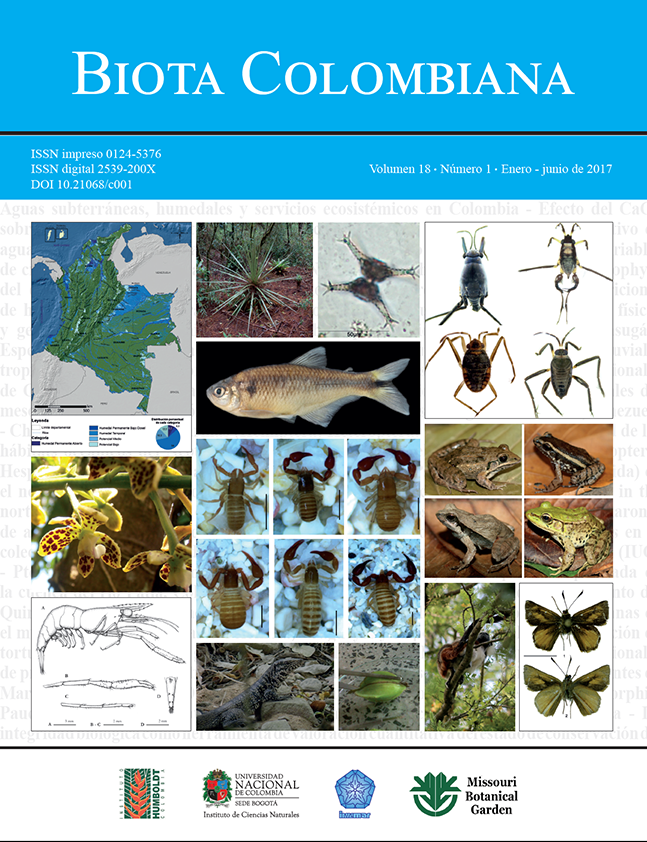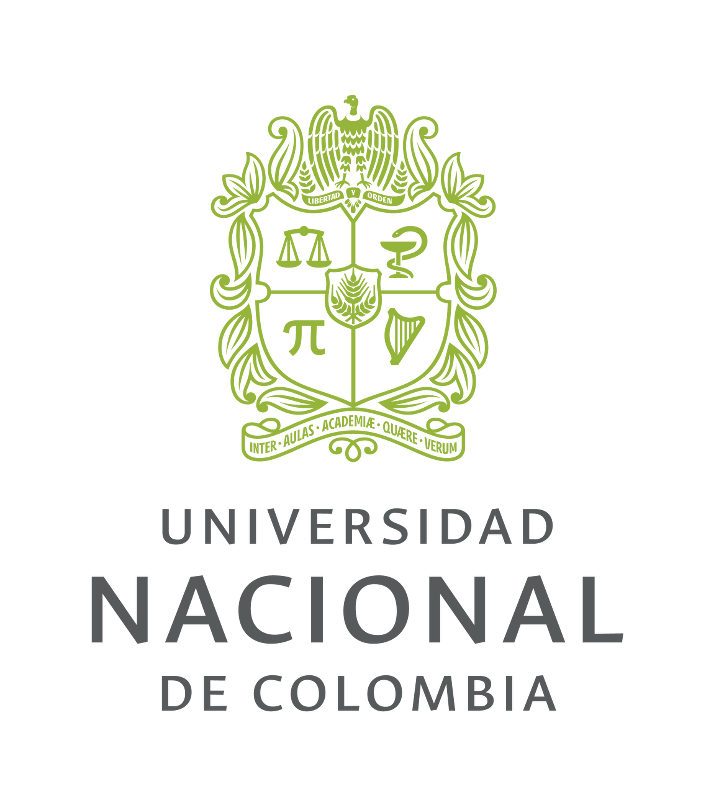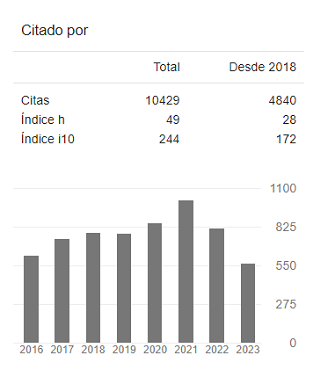Resumen (es):
Las chinches acuáticas del infraorden Gerromorpha son especies adaptadas a caminar o patinar sobre la
película superficial del agua principalmente en ambientes de agua dulce, sin embargo, algunas especies se han
adaptado a vivir en ambiente marinos y actualmente no se cuenta con un inventario de la riqueza y composición
de la fauna de chinches patinadoras marinas para el Neotrópico. A partir de la revisión bibliográfica, de los
especímenes depositados en colecciones entomológicas y expediciones en campo, se obtuvieron los registros
de chinches asociadas a ambientes marinos. A cada registro se les asignó una categoría de hábitat (estuarios/
manglares, lagunas formadas por arrecifes de coral, guarida de cangrejo en manglar, charcas formadas por las
mareas, mar cerca de la costa, ambientes pelágicos) y su distribución geográfica actualizada. Se registran 203
especies a nivel mundial de Gerromorpha en ambientes asociados a ecosistemas marinos. Para el Neotrópico
se registraron cinco familias, 13 géneros y 48 especies que representan el 23 % de las especies a nivel mundial.
En orden de riqueza de especies la familia Gerridae tuvo la mayor con 22 especies distribuidas en tres
géneros, seguida de Veliidae con 17 especies de cinco géneros, Mesoveliidae con seis especies y tres géneros,
Hermatobatidae con dos especies y un género, y por último Hebridae con un género y una especie.
Resumen (en):
Palabras clave:
Gerridae, Hermatobatidae, Mesoveliidae, Veliidae, Hebridae (en)
Referencias
Andersen, N. M. 1982. The semiaquatic Bugs (Hemiptera, Gerromorpha). Phylogeny, adaptations biography, and classification. Entomograph 3: 1–455.
Andersen, N. M. 1989. The coral bugs, genus Halovelia Bergroth (Hemiptera, Veliidae). I. History, Classification, and taxonomy of species except the H. malaya-group. Entomological Scandinavia 20: 75–120.
Andersen, N. M. 1998. Marine water striders (Heteroptera, Gerromorpha) of the Indo-Pacific: cladistic biography
and cenozoic paleogeography. Biogeography and Geological Evolution of the SE Asia 341–354.
Andersen, N. M. 1999. The evolution of marine insects: phylogenetic, ecological and geographical aspects of species diversity in marine water striders. Ecography 22: 98–111.
Andersen, N. M. y L. Cheng. 2004. The marine insect Halobates (Heteroptera: Gerridae) biology, adaptations, distribution and phylogeny. Oceanography and Marine Biology An Annual Review 42: 119–180.
Andersen, N. M. y G. O. Poinar. 1998. A marine water strider (Hemiptera: Veliidae) from Dominican amber. Entomologica Scandinavica 29: 1–9.
Andersen, N. y J. Polhemus. 1980. Four new genera of Mesoveliidae (Hemiptera, Gerromorpha) and the phylogeny and classification of the family. Entomologica scandinavica 11: 369–392.
Andersen, N. y T. Weir. 1999. The marine Haloveliinae (Hemiptera:Veliidae) of Australia, New Caledonia and southern New Guinea. Invertebrate Taxonomy 13: 309–350.
Barrera, J. V. 2014. Las chinches patinadoras (Hemiptera: Gerromorpha) en ecosistemas marinos del Caribe Colombiano. Trabajo de grado. Universidad Pedagógica y Tecnológica de Colombia, Facultad de Ciencias, Escuela de Biología. Tunja, 45 pp.
Camus, P. A. y R. M. Barahona. 2002. Insectos del intermareal de Concepción, Chile: perspectivas para la investigación ecológica. Revista Chilena de Historia Natural 75 (4): 793–803.
Carvalho, J. C. M. 1984. On a new species of intertidal water strider from Brazil (Hemiptera, Gerromorpha, Mesoveliidae). Amazoniana 8 (4): 519–523.
Castro-Vargas, M. y I. Morales-Castaño. 2011. The Rheumatobates Bergroth, 1892 (Hemiptera: Heteroptera: Gerridae) of Colombia, including the description of R. plumpes n. sp. and a key to represented species. Zootaxa 3040: 1–18.
Cheng, L. 2006. A bug on the ocean waves (Heteroptera, Gerridae, Halobates Eschscholtz). Denisia 19: 1033-1040.
Cheng, L. 1976. Marine Insects. North-Holland Publishing Company. Amsterdam The Netherlands, 581pp.
Cheng, L. y E. W. Leis. 1980. Notes on the seabed Hermatobates hawaiiensis China (Heteroptera: Hermatobatidae). Proceeding Hawaiian Entomological Society 23 (2): 193–197.
Cheng, L. y R. Lewin. 1971. An interesting marine insect, Rheumatobates aestuarius (Heteroptera: Gerridae), from Baja California, Mexico. Pacific Insects 13 (2): 333–341.
Cheng, L. y W. Mathis. 2003. Marine insects of Guam: Heteroptera and Diptera. Micronesica 35–36: 514–522.
Clapham, M. E, J. A. Karr y D. B. Nicholson, A. J Ross y P. J. Mayhew. 2016. Ancient origin of high taxonomic richness among insects. Proceeding of the Royal Society B 283: 2015–2476.
Damgaard, J., F. F. Moreira, M. Hayashi, T. Weir y A. Zettel. 2012. Molecular phylogeny of the pond treaders (Insecta: Hemiptera: Heteroptera: Mesoveliidae), discussion of the fossil record and a checklist of species assigned to the family. Insect Systematics & Evolution 43: 175–212.
Drake, C. J. 1958. New Neotropical Veliidae (Hemiptera). Proceedings of the Biological Society of Washington 71: 133–142.
Drake, C. J. y H. M. Harris.1933 New American Veliidae (Hemiptera). Proceedings of the Biological Society of Washington 46: 45–54.
Drake, C. J y P. H. Van Doesburg. 1966. Water–Striders of the American Genus Trochopus (Hemiptera: Veliidae). Studies on the Fauna of Suriname and Other Guyanas 31: 65–76
Epler, J. H. 2006. Identification manual for the aquatic and semi–aquatic Heteroptera of Florida (Belostomatidae, Corixidae, Gelastocoridae, Gerridae, Hebridae, Hydrometridae, Mesoveliidae, Naucoridae, Nepidae, Notonectidae, Ochteridae, Pleidae, Saldidae, Veliidae). Florida Department of Environmental Protection, Tallahassee, 195 pp.
Floriano, C. F. B. y F. F. F. Moreira. 2015. A new species of Rhagovelia Mayr, 1865 (Hemiptera: Heteroptera: Veliidae) from Brazil. Zootaxa 4018: 437–443.
Ferrú, M. y W. Sielfeld. 2010. Nuevos registros de Halobates splendens (Hemiptera: Gerridae) en el Norte de Chile y comentarios sobre la distribución en el Pacífico suroriental. Revista Chilena de Entomología 35: 83–87.
Hadden, F. C. 1931. The Pelagic Halobates. Proceedings Hawaiian Entomological Society 7: 457–459.
Henry, G. M. 1932. Note on the diving powers of Halobates. Spolia Zeylanica 16: 353–354.
Herring, J. L. 1958. The marine water-striders of the ‘Dana’ Expeditions (Insecta: Hemiptera). Dana Report 44: 1–14.
Herring, J. L. 1961. The genus Halobates (Hemiptera: Gerridae). Pacific Insects 3: 223–305.
Hungerford, H.B. 1954. The Genus Rheumatobates Bergoth (Hemiptera-Gerridae). The University of Kansas Science Bulletin 36 (7): 529–588.
Ikawa, T., H. Okabe y L. Cheng. 2012. Skaters of the seas comparative ecology of nearshore and pelagic Halobates
species (Hemiptera: Gerridae), with special reference to Japanese species. Marine Biology Research 8: 915–936.
Manzano, M. R., N. Nieser y G. Caicedo. 1995. Lista preliminar de heterópteros acuáticos en la Isla Gorgona y Llanura del Pacífico. Biblioteca José Jerónimo Triana 11: 47–72.
Molano, F., F.F.F. Moreira y I. Morales. 2016. New species and records of Microveliinae and Veliinae (Hemiptera: Heteroptera: Veliidae) from Colombia. Zootaxa 4171 (3): 575–585.
Molano-Rendón, F., I. T. Morales-Castaño y C. Serrato-Hurtado. 2008. Clasificación y Hábitats de Gerridae (Heteroptera-Gerromorpha) en Colombia. Acta Biológica Colombiana 13 (2): 41–60.
Moreira, F. F. F. 2015. The Semiaquatic Gerromorphans. Pp. 113–156. En: Panizzi A. y J. Grazia. (Eds.). True Bugs (Heteroptera) of the Neotropics. 1 ed. Dordrecht: Springer Science+Business Media, Brazil.
Moreira, F. F., J. R. I. Ribeiro y J. L. Nessimian. 2008. A synopsis of the species of Mesovelia (Insecta: Heteroptera: Mesoveliidae) occurring in the floodplain of the amazon river, Brazil, with redescriptions of Mesovelia mulsanti White and M. zeteki Harris & Drake. Acta Amazonica 38 (3): 539–550.
Moreira, F. F. F., J. L. Nessimian, J. A. Rúdio y F.F. Salles. 2010. New species and new records of Veliidae from Espírito Santo State and adjacent Minas Gerais State, Brazil, with notes on nomenclature (Insecta: Heteroptera: Gerromorpha). Journal of Natural History 44: 2761–2801.
Muñoz S., C. Naranjo y F. F. F. Moreira. 2012. New distributional records of Gerromorpha Popov, 1971 (Insecta: Hemiptera: Heteroptera) from Cuba. Check List 8 (2): 307–309.
Nieser, N. y M. Alkins-Koo. 1991. The water bugs of Trinidad & Tobago. Occasional Papers of the Zoology Department, University of the West Indies 9: 1–127.
Padilla-Gil, D. N. y O. Arcos. 2011. Hemiptera acuáticos asociados a los estuarios de la costa pacífica colombiana. Revista Colombiana de Entomología 37 (1): 350–353.
Padilla-Gil, D. N. y B. Pacheco-Chávez. 2012. New records of Rheumatobates Bergroth (Hemiptera: Heteroptera: Gerridae) from the Pacific coast of Colombia and Costa Rica, with a key to males of Rheumatobates in the Eastern Tropical Pacific. Zootaxa 3427: 33–46.
Padilla-Gil, D. N. y F. F. F. Moreira. 2013a. Checklist, taxonomy and distribution of the Rhagovelia Mayr, 1865 (Hemiptera: Heteroptera: Veliidae) of the Americas. Zootaxa 3640 (3): 409424.
Padilla-Gil, D. N. y F. F. F. Moreira. 2013b. Two new species of Microvelia Westwood, 1834 (Hemiptera: Heteroptera: Veliidae) from Colombia, with a key to Colombian species. Zootaxa 3745 (5): 587–595.
Polhemus, J. T. 1975. New estuarine and intertidal water from Mexico and Costa. The Pan–Pacific Entomologist 51 (3): 243–247.
Polhemus, J. T. 1991. Two new Neotropical genera of Trepobatinae (Gerridae: Heteroptera). Journal New York Entomologist Society 99 (1): 78–86.
Polhemus, J. T. y L. Cheng. 1976. A new Rheumatobates from Costa Rica (Hemiptera: Gerridae). The Pan–Pacific Entomologist 52 (4): 321–323.
Polhemus, J. T. y J. L. Herring. 1979. A Further description of Hermatobates bredini Herring and a new record for Cuba (Hemiptera: Hermatobatidae). Proceedings of the Entomological Society of Washington 81 (2): 253–254.
Polhemus, J. T. y C. L. Hogue. 1972. Two new Microvelia from crabholes in Costa Rica. Contributions in Science Natural History Museum Los Angeles 224: 1–6.
Polhemus, J.T. y L. Cheng. 1982. Notes on marine waterstrider with descriptions new species. Pacific Insects 24 (3–4): 219–227.
Polhemus, J. T. y M. R. Manzano. 1992. Marine Heteroptera of the eastern tropical Pacific (Gelastocoridae, Gerridae, Mesoveliidae, Saldidae, Veliidae). Pp. 302–320, 650, 660. En: Quintero, D. y A. Aiello. (Eds.). Insects of Panama and Mesoamerica: selected studies. Oxford University Press, Oxford, New York & Tokyo.
Polhemus, J. T. y D. A. Polhemus. 1989. A New Mesoveliid genus and two new species of Hebrus (Heteroptera: Mesoveliidae, Hebridae) from Intertidal habitats in Southeast Asian mangrove swamps. Raffles Bulletin of Zoology 37 (1–2): 73–82.
Polhemus J. T y D. A. Polhemus 1993. Two New Genera for New World Veliinae (Heteroptera: Veliidae). Journal of the New York Entomological Society 101 (3): 391–398.
Polhemus J. T. y D. A. Polhemus. 2012. A Review of the Genus Hermatobates (Heteroptera: Hermatobatidae), with Descriptions of Two New Species. Entomologica Americana 118 (1): 202–241.
Polhemus, J. T. y P. J. Spangler. 1989. A new species of Rheumatobates Bergroth from Ecuador and distribution of the genus (Heteroptera: Gerridae). Proceedings of the Entomological Society of Washington 91 (3): 421–428.
Prado, E. 2008. Conocimiento actual de Hemiptera – Heteroptera de Chile con lista de especies. Boletin del Museo Nacional de Historia Natural, Chile 57:31–75.
Rico, V. 1993. Origen y rutas de dispersión de los mangles: una revisión con énfasis en las especies de América. Acta Botánica Mexicana 25: 1–13.
Ruxton, G. y S. Humphries. 2008. Can ecological and evolutionary arguments solve the riddle of the missing marine insects?. Marine Ecology 29: 72–75.
Sekimoto, T., K. Iyota, Y. Osumi, T. Shiraki y T. Harada. 2013. Lowered Salinity Tolerance in Sea Skaters Halobates micans, Halobates sericeus, and Halobates sp. (Heteroptera: Gerridae). Environmental Entomology 42 (3): 572–577.
Westlake, K. P., L. Rowe y D. Currie. 2000. Phylogeny of the water strider genus Rheumatobates (Heteroptera: Gerridae). Systematic Entomology 25: 125–145.
Zettel, H. 2003. Notes on the marine Haloveliinae (Insecta: Heteroptera: Veliidae) of the Philippines, with descriptions of four new species, identification key, and classification of all species of Haloveloides Andersen, 1992. Naturhistorisches Museum Wien 104B: 163–181.
Zettel, H. 2004. Hebrus murphyi, new species (Heteroptera: Hebridae) from an intertidal mangrove habitat in Burias Island, Philippines. The Raffles Bulletin of Zoology 52 (1): 75–77.
Cómo citar
Las obras publicadas en las revistas del Instituto de Investigación de Recursos Biológicos Alexander von Humboldt están sujetas a los siguientes términos, con relación al derecho de autor:
1. Los derechos patrimoniales de las obras publicadas tienen como titular al Instituto de Investigación de Recursos Biológicos Alexander von Humboldt. Los autores o las instituciones que elaboran el documento aceptan ceder los derechos patrimoniales al Instituto Humboldt con el envío de sus artículos, lo que permite –entre otras cosas– la reproducción, comunicación pública, difusión y divulgación de las obras.
2. Las obras de ediciones digitales se publican bajo una licencia de Creative Commons Colombia:
Esta obra está bajo una Licencia Creative Commons Atribución-NoComercial-SinDerivar 4.0 Internacional.
Atribución – No comercial – Sin Derivar: Esta licencia es la más restrictiva de las seis licencias principales, sólo permite que otros puedan descargar las obras y compartirlas con otras personas, siempre que se reconozca su autoría, pero no se pueden cambiar de ninguna manera ni se pueden utilizar comercialmente.
3. Los autores, al someter artículos al proceso editorial de las revistas editadas por el Instituto Humboldt, aceptan las disposiciones institucionales sobre derechos de autor y acceso abierto.
4. Todos los artículos recibidos serán sometidos a un software antiplagio. El sometimiento de un artículo a las revistas del Instituto Humboldt se entiende como la aceptación de la revisión para detectar posible plagio.
5. Las obras sometidas al proceso de edición de las revistas del Instituto Humboldt deben ser inéditas.


















